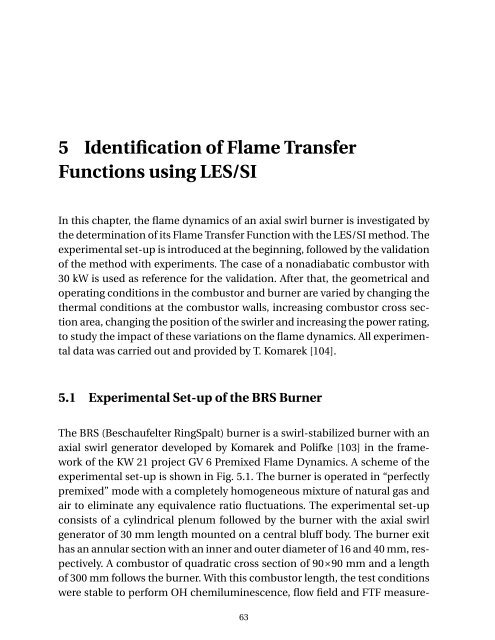Numerical Simulation of the Dynamics of Turbulent Swirling Flames
Numerical Simulation of the Dynamics of Turbulent Swirling Flames
Numerical Simulation of the Dynamics of Turbulent Swirling Flames
You also want an ePaper? Increase the reach of your titles
YUMPU automatically turns print PDFs into web optimized ePapers that Google loves.
5 Identification <strong>of</strong> Flame Transfer<br />
Functions using LES/SI<br />
In this chapter, <strong>the</strong> flame dynamics <strong>of</strong> an axial swirl burner is investigated by<br />
<strong>the</strong> determination <strong>of</strong> its Flame Transfer Function with <strong>the</strong> LES/SI method. The<br />
experimental set-up is introduced at <strong>the</strong> beginning, followed by <strong>the</strong> validation<br />
<strong>of</strong> <strong>the</strong> method with experiments. The case <strong>of</strong> a nonadiabatic combustor with<br />
30 kW is used as reference for <strong>the</strong> validation. After that, <strong>the</strong> geometrical and<br />
operating conditions in <strong>the</strong> combustor and burner are varied by changing <strong>the</strong><br />
<strong>the</strong>rmal conditions at <strong>the</strong> combustor walls, increasing combustor cross section<br />
area, changing <strong>the</strong> position <strong>of</strong> <strong>the</strong> swirler and increasing <strong>the</strong> power rating,<br />
to study <strong>the</strong> impact <strong>of</strong> <strong>the</strong>se variations on <strong>the</strong> flame dynamics. All experimental<br />
data was carried out and provided by T. Komarek [104].<br />
5.1 Experimental Set-up <strong>of</strong> <strong>the</strong> BRS Burner<br />
The BRS (Beschaufelter RingSpalt) burner is a swirl-stabilized burner with an<br />
axial swirl generator developed by Komarek and Polifke [103] in <strong>the</strong> framework<br />
<strong>of</strong> <strong>the</strong> KW 21 project GV 6 Premixed Flame <strong>Dynamics</strong>. A scheme <strong>of</strong> <strong>the</strong><br />
experimental set-up is shown in Fig. 5.1. The burner is operated in “perfectly<br />
premixed” mode with a completely homogeneous mixture <strong>of</strong> natural gas and<br />
air to eliminate any equivalence ratio fluctuations. The experimental set-up<br />
consists <strong>of</strong> a cylindrical plenum followed by <strong>the</strong> burner with <strong>the</strong> axial swirl<br />
generator <strong>of</strong> 30 mm length mounted on a central bluff body. The burner exit<br />
has an annular section with an inner and outer diameter <strong>of</strong> 16 and 40 mm, respectively.<br />
A combustor <strong>of</strong> quadratic cross section <strong>of</strong> 90×90 mm and a length<br />
<strong>of</strong> 300 mm follows <strong>the</strong> burner. With this combustor length, <strong>the</strong> test conditions<br />
were stable to perform OH chemiluminescence, flow field and FTF measure-<br />
63
















